Sarnath
Sarnath (Hindustani pronunciation: [saːɾnaːtʰ]) is a place located 10 kilometres (6.2 mi) northeast of Varanasi near the confluence of the Ganges and the Varuna rivers in Uttar Pradesh, India. The Deer Park in Sarnath is where Gautama Buddha first taught the Dharma, and where the Buddhist Sangha came into existence through the enlightenment of Kondanna (Sanskrit: Kauṇḍinya).
Sarnath | |
|---|---|
Historical City | |
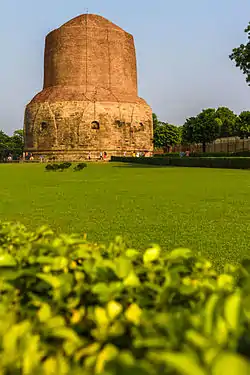 The Dhamekh Stupa, Sarnath | |
| Nickname: Isipatana | |
 Sarnath  Sarnath | |
| Coordinates: 25.3811°N 83.0214°E | |
| Country | |
| State | Uttar Pradesh |
| District | Varanasi |
| Languages | |
| • Official | Hindi |
| Time zone | UTC+5:30 (IST) |
| Pilgrimage to |
| Buddha's Holy Sites |
|---|
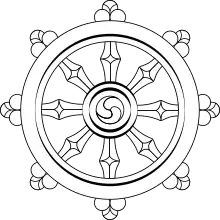 |
| Part of a series on |
| Buddhism |
|---|
 |
|
Singhpur, a village approximately 1 kilometre (0.62 mi) away from the site, was the birthplace of Shreyansanath, the Eleventh Tirthankara of Jainism. A temple dedicated to him is an important pilgrimage site.
Also referred to as Isipatana, this city is mentioned by the Buddha as one of the four places of pilgrimage his devout followers should visit.[1] It was also the site of the Buddha's Dhammacakkappavattana Sutta, which was his first sermon after attaining enlightenment, in which he explained the Four Noble Truths and the teachings associated with them.
Origin of names
Sarnath has been variously known as Mrigadava, Migadāya, Rishipattana and Isipatana throughout its long history. Mrigadava means "deer-park". "Isipatana" is the name used in the Pali Canon, and means the place where holy men (Pali: isi, Sanskrit: rishi) landed.[2]
The legend says that when the Buddha-to-be was born, some devas came down to announce it to 500 rishis.
Sarnath derives from the Sanskrit Sāranganātha,[3] which means "Lord of the Deer", and relates to another old Buddhist story in which the Bodhisattva is a deer and offers his life to a king instead of the doe the latter is planning to kill. The king is so moved that he creates the park as a sanctuary for deer. The park is active in modern times.
History

Isipatana after the Buddha

Buddhism flourished in Sarnath because of kings and wealthy merchants based in Varanasi. By the third century, Sarnath had become an important centre for the arts, which reached its zenith during the Gupta period (4th to 6th centuries CE). In the 7th century by the time Xuanzang visited from China, he found 30 monasteries and 3000 monks living at Sarnath.[4]
Sarnath became a major centre of the Sammatiya school of Buddhism, one of the early Buddhist schools. However, the presence of images of Heruka and Tara indicate that Vajrayana Buddhism was (at a later time) also practised here. Also, images of Hindu gods as Shiva and Brahma were found at the site, and there is still a Jain temple (at Chandrapuri) located very close to the Dhamekh Stupa.
Kumaradevi, the Gahadvala queen, constructed the last structures at Sarnath. In 1193, her grandson, Jaichand of Kannauj was defeated by Qutb al-Din Aibak, a general of Muhammad Ghori. At the end of the 12th century, Sarnath was sacked by Turkish Muslims, and the site was subsequently plundered for building materials.
Destructions and demise in the 12th century
Islamic invasions , especially under the Ghurid Empire general Qutb-ud-din Aibek in 1193, bought massive plunder and destructions. Qutb-ud-din Aibek, the military commander of Muhammad of Ghor's army, marched towards Varanasi, where he is said to have destroyed idols in a thousand temples. Sarnath very likely was among the casualities of this invasion, one all too often seen as a Muslim invasion whose primary purpose was iconoclasm.
Jainism
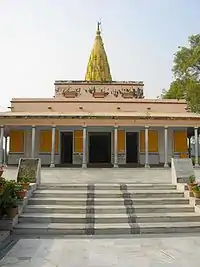
Sarnath is the birthplace of the 11th Tirthankara Shri Shreyansanatha Bhagwan. It is the place where 4 of the 5 kalyanak (auspicious life events) of Shri Shreyansanatha Bhagwan took place.
- Shri Digambar Jain Shreyansnath Mandir, Singhpuri, Sarnath
It is the place of 4 kalyanak of Shri Shreyansnath Bhagwan. A huge ashtakod stoop (octagonal pillar), 31.4 metres (103 ft) in height is still present showing its historical establishment. It is considered to be 2200 years old. The main deity of this temple is a blue-coloured idol of Shri Shreyansnath Bhagwan, 75 centimetres (30 in) in height, in Padmāsana.
Current features of Isipatana

The major excavated ruins are listed below, generally in north-to-south and west-to-east order.
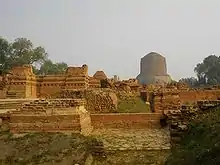
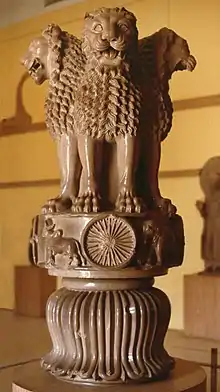
Most of the ancient buildings and structures at Sarnath were damaged or destroyed by the Turks. However, amongst the ruins can be distinguished:
- The Dharma Chakra Jina Vihar, constructed by Kumaradevi, a wife of Gahadavala Govindachandra (c. 1114–1155 CE). An inscription mentions the building of this massive vihara. It mentions that Govindachandra had protected Varanasi from the Turushkas. This was the last construction at Sarnath before it was devastated.[5]
- The Ashoka Pillar erected here, originally surmounted by the "Lion Capital of Ashoka" (presently on display at the Sarnath Museum), was broken during Turk invasions but the base still stands at the original location. The Lion Capital now symbolizes the modern state of India. The Lion Capital served as the base of a large 32-spoke stone dharma-chakra, which was found broken into many pieces.[6] The seal of the Supreme court of India displays the Dharma Chakra as it must have originally appeared.[7]
- The ruins of the Mulagandhakuti vihara mark the place where the Buddha spent his first rainy season. This was the main temple marked by the presence of the Ashoka Pillar at the front. The famous Sarnath Buddha in dharmachakra pravartana mudra was found in the vicinity.
- The Dharmarajika Stupa is one of the few pre-Ashokan stupas remaining, although only the foundations remain. The rest of the Dharmarajika Stupa was removed to Varanasi to be used as building materials in the 18th century. At that time, relics (bone fragments) in a casket, were found in the Dharmarajika Stupa. These relics were subsequently thrown in the Ganges river, but the casket is preserved.
- The Dhamek Stupa; it is an impressive structure, 39 metres (128 ft) high and 28 metres (92 ft) in diameter.
- The Chaukhandi Stupa commemorates the spot where the Buddha met his first disciples, dating back to the fifth century or earlier and later enhanced by the addition of an octagonal tower of Islamic origin. In recent years it is undergoing restoration.
- Digambar Jain Mandir: while the current structure is from the 19th century, it occupies an ancient spot.
- The modern Mulagandhakuti Vihara is a temple constructed in the 1930s by the Mahabodhi Society, with beautiful wall paintings with a replica of the famous Sarnath Buddha in dharmachakra pravartana mudra.[8] Behind it is the Deer Park (where deer are still to be seen).
- The Sarnath Archeological Museum houses the famous Ashokan lion capital, which miraculously survived its 45-foot drop to the ground (from the top of the Ashokan Pillar), and became the National Emblem of India and national symbol on the Indian flag. The museum also houses a famous and refined sculpture of the Buddha in Dharmachakra-posture.
- There is also a Bodhi tree planted by Anagarika Dharmapala which has grown from a cutting of the Bodhi Tree at Bodh Gaya.
For Buddhists, Sarnath (or Isipatana) is one of four pilgrimage sites designated by Gautama Buddha, the other three being Kushinagar, Bodh Gaya, and Lumbini.
Modern-day pilgrimage
Sarnath has been developed as a place of pilgrimage, both for Buddhists from India and abroad. A number of countries in which Buddhism is a major (or the dominant) religion, such as Thailand, Japan, Tibet, Sri Lanka, and Myanmar, have established temples and monasteries in Sarnath in the style that is typical for the respective country. Thus, pilgrims and visitors have the opportunity to experience an overview of Buddhist architecture from various cultures. There is a 24-m-tall (80-foot) statue of Buddha constructed over 14 years (1997-2011) by joint Indo-Thai efforts.[9] It is said to be inspired by the Buddhas of Bamiyan.[10]
| Year | International | Domestic | Total |
|---|---|---|---|
| 2013 | 362,113 | 838,566 | 1,200,679 |
| 2014 | 374,268 | 899,457 | 1,273,725 |
| 2015 | 388,102 | 924,552 | 1,312,654 |
| 2016 | 409,242 | 957,320 | 1,366,562 |
| 2017 | 430,682 | 1,024,589 | 1,455,271 |
In English literature
The plate, based on a picture by Samuel Prout, on which Letitia Elizabeth Landon's poem Sarnat a Boodh Monument is based, shows its then run-down condition, and her words, comparing the religions of the world, pick up on the apparent weakness of Buddhism in the country of its origin at that time (1832).
Sarnath is one of the locations of Rudyard Kipling's 1901 novel Kim.[12] Teshoo Lama stays at the Temple of the Tirthankhars in Sarnath when not on his pilgrimages. Kim meets him there after he leaves Saint Xavier's school.
H.P. Lovecraft in his story titled The Nameless City, described the ruins of an ancient civilization so old that other now collapsed civilizations where not yet built when it saw its last day. Amongst the list of cities was Sarnath, which Lovecraft described as "Sarnath The Doomed".
Gallery
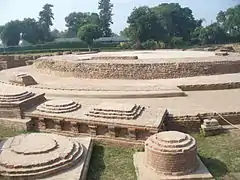 Dharmarajika Stupa from the pre-Ashokan Era
Dharmarajika Stupa from the pre-Ashokan Era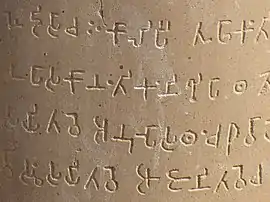
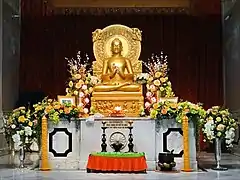 Buddha image at Sarnath, a replica of the excavated Dharmachakra Pravartana Buddha at Sarnath
Buddha image at Sarnath, a replica of the excavated Dharmachakra Pravartana Buddha at Sarnath.jpg.webp) Mulagandhakuti fresco by Kosetsu Nosu
Mulagandhakuti fresco by Kosetsu Nosu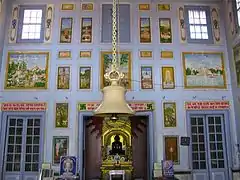 Interior of Sri Digamber Jain Shreyansnath Mandir
Interior of Sri Digamber Jain Shreyansnath Mandir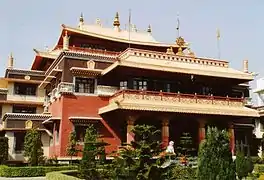 Temple of the Tibetan community in Sarnath
Temple of the Tibetan community in Sarnath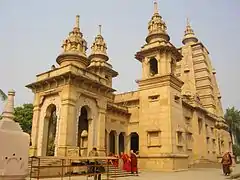 Mulagandhakuti Vihara, Mahabodhi Society Buddhist temple at Sarnath
Mulagandhakuti Vihara, Mahabodhi Society Buddhist temple at Sarnath Head of West Asian foreigner, Sarnath.[13]
Head of West Asian foreigner, Sarnath.[13] Sarnath Mauryan capital.
Sarnath Mauryan capital.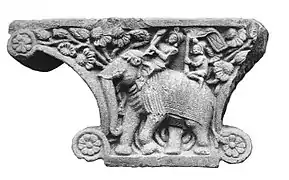 Sarnath capital with an elephant.
Sarnath capital with an elephant.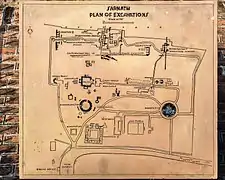 Sarnath - Plan of Excavations and constructions.
Sarnath - Plan of Excavations and constructions.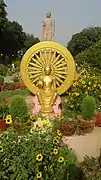 View of Lord Buddha at Thai Temple Sarnath Varanasi.
View of Lord Buddha at Thai Temple Sarnath Varanasi. Buddha statue inside a votive stupa, Sarnath
Buddha statue inside a votive stupa, Sarnath
See also
- Adi Badri (Haryana)
- Pillars of Ashoka
- Kanaganahalli and Sannati in North Karnataka
Notes
- (D.ii.141)
- Sen, Dr. A. (2008). Buddhist remains in India. Calcutta: Maha Bodhi Book Agency. pp. 30–34. ISBN 978-81-87032-78-6.
- Schuman, Hans Wolfgang (2004). The Historical Buddha: The Times, Life, and Teachings of the Founder of Buddhism. Motilal Banarsidass. p. 67.
- Karkar, S.C. (2009). The Top Ten Temple Towns of India. Kolkota: Mark Age Publication. p. 14. ISBN 978-81-87952-12-1.
- The word Jina in the name of this vihara means Buddha, not a Jain Tirthankara.
- Reverence, Resistance and Politics of Seeing the Indian National Flag, Sadan Jha, Cambridge University Press, 2016, p.117, footnote 59
- 32 Spokes Of Wisdom Our national symbol, the Ashoka pillar, has an upper chakra missing. An MP pointed it out to Nehru, but was ignored, DOLA MITRA, Outlook India, 18 January 2016
- Nakamura, Hajime (2000). Gotama Buddha. Kosei. p. 267. ISBN 4-333-01893-5.
- Sarnath gets country's tallest statue of Buddha, March 16, 2011
- It’s not quite Bamiyan but…, Tricycle, NOV 02, 2009
- "ANNUAL TOURIST VISITS STATISTICS- 2013, 2014, 2015, 2016, 2017" (PDF). UP Tourism.
- Kipling, Rudyard (1901). Kim. London: MacMillan & Co. p. 266. ISBN 9781974908677.
- Page 122: About the Masarh lion: "This particular example of a foreign model gets added support from the male heads of foreigners from Patna city and Sarnath since they also prove beyond doubt that a section of the elite in the Gangetic Basin was of foreign origin. However, as noted earlier, this is an example of the late Mauryan period since this is not the type adopted in any Ashoka pillar. We are, therefore, visualizing a historical situation in India in which the West Asian influence on Indian art was felt more in the late Mauryan than in the early Mauryan period. The term West Asia in this context stands for Iran and Afghanistan, where the Sakas and Pahlavas had their base camps for eastward movement. The prelude to future inroads of the Indo-Bactrians in India had after all started in the second century B.C."... in Gupta, Swarajya Prakash (1980). The Roots of Indian Art: A Detailed Study of the Formative Period of Indian Art and Architecture, Third and Second Centuries B.C., Mauryan and Late Mauryan. B.R. Publishing Corporation. pp. 88, 122. ISBN 978-0-391-02172-3..
References
- Rai Bahadur Daya Ram Sahni: Guide to the Buddhist Ruins of Sarnath with a Plan of Excavations and Five Photographic Plates. Archaeological Survey of India, Delhi 1922
- Reprint: Antiquarian Book House, Delhi/Varanasi, 1982-1983
- Satyarth Nayak: The Emperor's Riddles 2014
External links
 Sarnath travel guide from Wikivoyage
Sarnath travel guide from Wikivoyage- Entry on Isipatana in the Buddhist Dictionary of Pali Proper Names
- Description of Sarnath by the Chinese pilgrim monk Faxian (399-414 AC)

